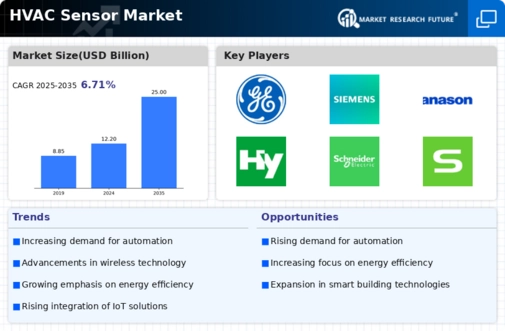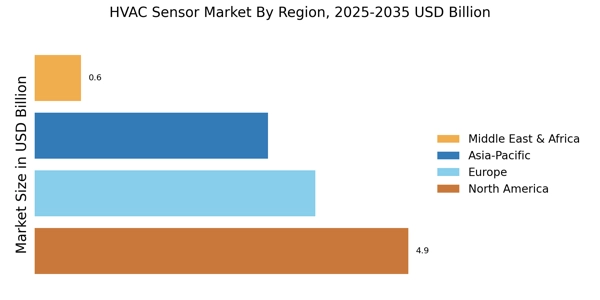Government Regulations and Incentives
The HVAC Sensor Market is significantly impacted by government regulations and incentives aimed at promoting energy efficiency and sustainability. Many governments are implementing stringent standards for HVAC systems, encouraging the adoption of advanced sensor technologies. Incentives such as tax credits and rebates for energy-efficient upgrades further stimulate market growth. Recent data suggests that regions with robust regulatory frameworks experience higher adoption rates of HVAC sensors, as stakeholders seek compliance and cost savings. As these regulations evolve, the HVAC Sensor Market is likely to see increased investment in innovative sensor solutions that meet or exceed regulatory requirements.
Rising Awareness of Indoor Air Quality
The HVAC Sensor Market is increasingly shaped by the growing awareness of indoor air quality (IAQ) among consumers and businesses. Poor IAQ has been linked to various health issues, prompting a demand for solutions that monitor and improve air quality. HVAC sensors equipped with air quality monitoring capabilities are becoming essential in both residential and commercial settings. Data indicates that the market for IAQ sensors is expected to expand significantly, driven by heightened consumer awareness and regulatory requirements. As organizations strive to create healthier environments, the HVAC Sensor Market is likely to benefit from the integration of advanced sensors that provide real-time feedback on air quality parameters.
Expansion of Smart Building Initiatives
The HVAC Sensor Market is benefiting from the expansion of smart building initiatives across various sectors. As urbanization continues to rise, the need for efficient building management systems becomes increasingly critical. Smart buildings utilize advanced HVAC sensors to optimize energy use, enhance occupant comfort, and streamline maintenance processes. The market for smart building technologies is projected to grow, with estimates indicating a potential increase in investment by billions of dollars over the next few years. This trend is likely to drive demand for sophisticated HVAC sensors that can seamlessly integrate with building management systems, thereby propelling the HVAC Sensor Market forward.
Increasing Demand for Energy Efficiency
The HVAC Sensor Market is experiencing a notable surge in demand for energy-efficient solutions. As energy costs continue to rise, consumers and businesses alike are seeking ways to reduce their energy consumption. HVAC sensors play a crucial role in optimizing heating, ventilation, and air conditioning systems, thereby enhancing energy efficiency. According to recent data, the implementation of advanced HVAC sensors can lead to energy savings of up to 30%. This trend is further fueled by regulatory frameworks that encourage energy-efficient practices, compelling manufacturers to innovate and integrate smart technologies into their products. Consequently, the HVAC Sensor Market is poised for growth as stakeholders prioritize sustainability and cost-effectiveness.
Technological Advancements in Sensor Technology
The HVAC Sensor Market is significantly influenced by rapid technological advancements in sensor technology. Innovations such as wireless sensors, smart thermostats, and advanced data analytics are transforming traditional HVAC systems into intelligent networks. These technologies enable real-time monitoring and control, enhancing system performance and user experience. The market for smart sensors is projected to grow substantially, with estimates suggesting a compound annual growth rate of over 20% in the coming years. As manufacturers continue to invest in research and development, the HVAC Sensor Market is likely to witness the introduction of more sophisticated and reliable sensor solutions, catering to the evolving needs of consumers.

















Leave a Comment